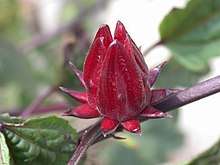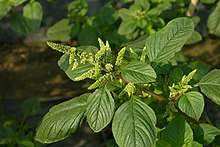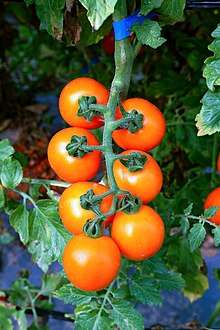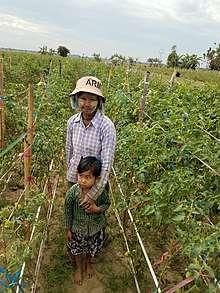World Vegetable Center
The World Vegetable Center (WorldVeg) (Chinese: 亞蔬—世界蔬菜中心), previously known as the Asian Vegetable Research and Development Center, is an international, nonprofit institute for vegetable research and development.[2] It was founded in 1971 in Shanhua, southern Taiwan, by the Asian Development Bank, Taiwan, Republic of Korea, Japan, the Philippines, Thailand, the United States and Vietnam.
| Formation | 1971 |
|---|---|
| Type | Nonprofit |
| Purpose | Vegetable research and development |
| Headquarters | 60 Yi-Min Liao, Shanhua, Tainan, Taiwan |
Region served | Worldwide |
Director General | Marco Wopereis[1] |
| Website | avrdc.org |
WorldVeg aims to reduce malnutrition and alleviate poverty in developing nations through improving production and consumption of vegetables.[3]
Research and development




The use of vegetables as crops that are of high worth is important in the Sustainable Development Goals of the United Nations Development Program and the World Vegetable Center.[5] The vegetables bred by the Center can be used in poorer areas, where they can serve as an important source of income and can help fight micronutrient deficiencies.[6]
The Center’s current crop portfolio focuses on several groups of globally important vegetables, according to the WorldVeg:
Indigenous or traditional vegetables, particularly those of Asia and Africa are another focus of research at the World Vegetable Center.[9] Indigenous vegetables are domesticated or semi-wild vegetable crops that are grown in particular regions as an integral part of a local food system. Many of them are underutilized crops,[10] particularly in regions where they are not native.[11]
Germplasm collection
A collection of vegetable germplasm is kept at the World Vegetable Center, which is considered to have the largest and most diverse collection in the world.[12] The collection itself contains more than 60,000 accessions of 442 different species collected from 156 countries.[13][14][15]
AVGRIS, the WorldVeg Vegetable Genetic Resources Information System, provides access to all the Center's data associated with germplasm conservation and management, from registration, characterization, evaluation, and seed inventory to seed distribution.[16]
Action to fight climate change
According to The Public Broadcasting Service (PBS), "At the World Vegetable Center, experts are looking to the wild relatives of domesticated crops to save the human diet from climate change."[17][18]
References
- "Searca, WorldVeg partner for joint research to address nutrition security". BusinessMirror. Retrieved 26 January 2019.
- Tomato yellow leaf curl virus disease: management, molecular biology, breeding for resistance by Henryk Czosnek, シュプリンガー・ジャパン株式会社, 2007, Pg. 417
- United Nations Development Programme [UNDP]. 2010. MDG Good Practices. Chapter 1: Poverty, Employment, and Hunger. pp. 74, 80, 95, 96, 105. http://www.undg-policynet.org/ext/MDG-Good-Practices/GP_chapter1_poverty.pdf
- "Cherry/high beta carotene tomato". World Vegetable Center. Retrieved 26 January 2019.
- United Nations Sustainable Development Goals Goal 2: End hunger, achieve food security and improved nutrition and promote sustainable agriculture.
- Weinberger KM, Lumpkin TA. 2005. Horticulture for Poverty Alleviation – The Unfunded Revolution. Available at SSRN: http://ssrn.com/abstract=781784
- The great pyramid: Ty tomatoes resist pests and diseases R4D
- "To Secure the Future of Food, Look to the Ancestors of Eggplant". www.pbs.org. Retrieved 26 January 2019.
- Cernansky, Rachel (23 February 2016). "Kenyans Reacquire an Old Taste: Eating Healthier". Opinionator. Retrieved 28 January 2019.
- New Agriculturalist. 2008. Making more of undervalued crops. http://www.new-ag.info/pov/views.php?a=426
- Vikram, "How green was my veggie", The Economic Times, June 30, 2007
- Food and Agriculture Organization of the United Nations [FAO]. 2009. Draft Second Report on the State of the World’s Plant Genetic Resources for Food and Agriculture, p. 60. Commission on Genetic Resources for Food and Agriculture. ftp://ftp.fao.org/docrep/fao/meeting/017/ak528e.pdf
- International Innovation. 2014. "The need for dietary diversity." Issue 155.
- "Green inheritance: the WWF book of plants" by Anthony Julian Huxley and Martin Walters, University of California Press, 2005, Pg. 169,
- "At this bank for vegetables, withdrawals produce interest" by R4D
- "SINGER makes AVRDC's Information on Vegetable Genetic Diversity Available", SGRP Annual Report 2004/2005 of the CGIAR System-wide Genetic Resources Programme by Bioversity International
- "To Secure the Future of Food, Look to the Ancestors of Eggplant". www.pbs.org. Retrieved 30 January 2019.
- "World vegetable center Strategic plan 2017-2025" (PDF). Worldveg. Retrieved 30 January 2019.